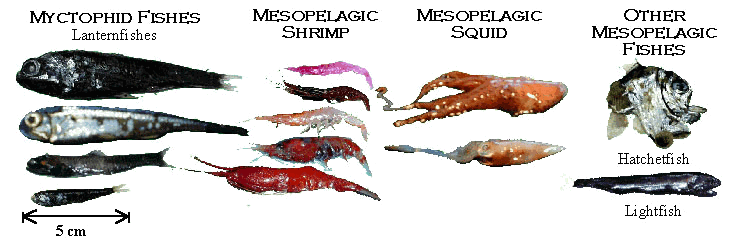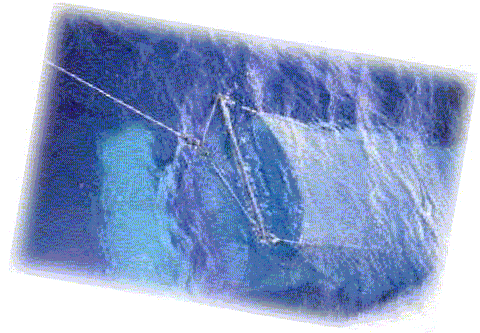[ Lay Language Paper Index | Press Room ]
Energy: Converting from Acoustical to Biological Resource Units
Kelly J. Benoit-Bird - benoit@hawaii.edu
Whitlow W. L. Au
Hawaii Institute of Marine Biology
P.O. Box 1106
Kailua, HI 96734
Popular version of paper 4aAOb6
Presented Thursday morning, December 6, 2001
142nd ASA Meeting, Fort Lauderdale, FL

The Setting
The mesopelagic boundary community in the Hawaiian Islands
is a land-associated community of small, midwater fishes, shrimps, and squids.
This community migrates every night from deep water into the shallower waters
around the islands. It serves as an important food resource for many predators
including spinner dolphins, deepwater snappers, tunas, and billfish. The
dynamics of the boundary community are likely to be important to the energetics
of these predators, but the biological energy available in the boundary community
remains unknown. As a result, it is difficult to determine if the boundary
community can solely sustain large populations of many predators, or if the
predators must rely on other resources as well. Monitoring this community
has been difficult. Net trawling for these mesopelagic animals is time consuming
and the number of animals captured is often artificially low because they
can avoid the net. Because the mesopelagic animals live so deep, there
is no feasible way to determine how many animals are avoiding the tow net.
Surveying the boundary community using remote techniques, such as sonar,
is desirable because it reduces costs, facilitates the monitoring of greater
areas, and dramatically reduces avoidance by the mesopelagic animals.
The Specific Problem
The data obtained from sonar systems are often converted into
estimates of animal abundance. This requires information on the acoustic scattering
properties of the animals in question and the size distribution of individuals
in the population, which is often unavailable. Biologists, however, often
need information on the amount of biological energy available to higher trophic
levels (i.e., higher levels of the food chain), not just the numbers of prey.
To convert acoustic measures to biomass, standard length-weight relationships
for the species are applied to the abundance estimates. This requires two
steps and consequently, compounds the error in the estimate of biomass. Alternatively,
acoustic energy is taken as a direct index of biomass, allowing relative comparisons
to be made, but not permitting estimates of the actual available biological
energy in a population. This direct use of acoustic energy as an index of
biomass has also not been directly validated.

Methods
We measured the acoustic scattering characteristics of live
animals from the mesopelagic boundary community using a 200 kHz sonar system.
The animals were captured using a midwater trawl and kept alive aboard the ship
until acoustic measures could be taken. The animals were then frozen and
transported to the laboratory where we measured various units of biomass on the
same animals including dry weight, ash-free dry weight, volume, and calories.
The acoustic data was then compared with the biomass data from each fish,
shrimp, and squid to determine if there were any predictable
relationships.
Conclusion
There were strong relationships between all the variables measured, making
it possible to approximate any one measure from the others within a class
of animals. This means that for these midwater animals, acoustic scattering
from sonar can be used as an index of biomass, a common practice which has
not been previously validated. Acoustic energy predicted biomass measures
at least as well as body length, a standard predictor. The relationships
between acoustic energy and all biomass measures from Hawaiian mesopelagic
animals were linear and additive. Consequently, it is possible to directly
convert acoustic energy from these animals to organic biomass units without
having knowledge of the size distribution of the populations being studied,
reducing potential error.

In summary, for the Hawaiian mesopelagic boundary community

Acoustic scattering from sonar can be used as an index of biomass

It is possible to directly convert acoustic energy to organic resource
units - without an intermediate step
We do not yet know if these conclusions can be generalized to other animals.
These types of paired measures of acoustic and biological energy need to become
a routine part of controlled acoustic studies.
Most importantly, these measures give us a way to study the energetics of
the mesopelagic boundary community around the Hawaiian Islands. Preliminary
application of the results of this study show that the boundary community
around the islands can have energetic densities as high as 186 kcals/m^3.
This important food base links the nearshore and open ocean systems around
the islands. Understanding the dynamics of the energy in this trophic level
are crucial to our comprehension of the many fisheries that depend on this
resource, as well as the biology of the spinner dolphins.
During the meeting, the presenter may be contacted at the Ft. Lauderdale
Marina Marriott Hotel.
[ Lay Language Paper Index | Press Room ]


